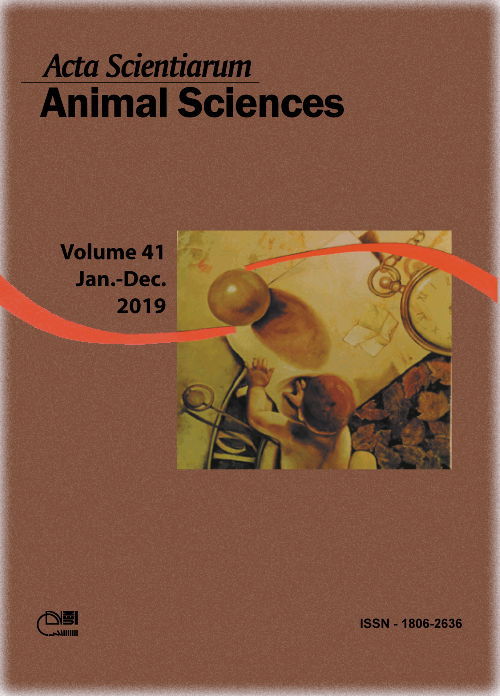Leaf area estimate of <i>Pennisetum glaucum<i> by linear dimensions
Resumo
Leaf area measurements are of the main parameters used in agronomic studies to evaluate plant growth. The current study used a non-destructive method based on linear leaf dimensions (length and width) to select the regression model to estimate millet (Pennisetum glaucum) leaf area. For two millet genotype (IPA BULK 1 BF and ADR 300) 128 randomly-chosen leaves were measured at different vegetative growth stages. Measures of length and width of each leaf were made using digital calipers. Leaf area was measured using a gravimetric method. The best-fit leaf area estimation model was selected via linear, potential and gamma regression models. Leaf area values varied from 3.02 to 209.21 cm2. The average value was 95.31 cm2. The potential regression model exhibited lower residual sum of squares and Akaike's information criterion and similar determination coefficient and Willmott index. Thus, potential regression was more efficient in explaining the leaf area of millet, independent of the genotype, when compared to other models evaluated in this research. Length (L) and width (W) could be used in the following potential regression model to estimate millet leaf blade.
Downloads
Referências
Achten, W. M. J., Maes, W. H., Reubens, B., Mathijs, E., Singh, V. P., Verchot, L., & Muys, B. (2010). Biomass production and allocation in Jatropha curcas L. seedlings under different levels of drought stress. Biomass and Bioenergy, 34(5), 667-676. doi: 10.1016/j.biombioe.2010.01.010.
Akaike, H. (1974). A new look at the statistical model identification. Automatic Control, IEEE Transactions on Automatic Control, 19(6), 716-723. doi: 10.1109/TAC.1974.1100705.
Antunes, W. C., Pompelli, M. F., Carretero, D. M., & DaMatta, F. M. (2008). Allometric models for non‐destructive leaf area estimation in coffee (Coffea arabica and Coffea canephora). Annals of Applied Biology, 153(1), 33-40. doi: 10.1111/j.1744-7348.2008.00235.x.
Aquino, L. A., Santos Júnior, V. C., Guerra, J. V. S., & Costa, M. M. (2011). Estimativa da área foliar do girassol por método não destrutivo. Bragantia, 70(4), 832-836. doi: 10.1590/S0006-87052011000400015.
Bianco, S., Carvalho, L. B., & Bianco, M. S. (2008). Estimativa da área foliar de Sida cordifolia e Sida rhombifolia usando dimensões lineares do limbo foliar. Planta Daninha, 26(4), 807-813. doi: 10.1590/S0100-83582008000400012.
Cargnelutti Filho, A., Toebe, M., Burin, C., Fick, A. L., Neu, I. M. M., & Facco, G. (2012). Estimação da área foliar de mucuna cinza por meio de método não destrutivo. Ciência Rural, 42(2), 238-242. doi: 10.1590/S0103-84782012000200009.
Casaroli, D., & Van lier, Q. J. (2008). Critérios para determinação da capacidade de vaso. Revista Brasileira de Ciência do Solo, 32(1), 59-66. doi: 10.1590/S0100-06832008000100007.
Flumignan, D. L., Adami, M., & Faria, R. T. (2008). Área foliar de folhas íntegras e danificadas de cafeeiro determinada por dimensões foliares e imagem digital. Coffee Science, 3(1), 1-6. doi: 10.25186/cs.v3i1.67.
Kandiannan, K., Parthasarathy, U., Krishnamurthy, K. S., Thankamani, C. K., & Srinivasan, V. (2009). Modeling individual leaf area of ginger (Zingiber officinale Roscoe) using leaf length and width. Scientia Horticulturae, 120(4), 532-537. doi: 10.1016/j.scienta.2008.11.037.
Köppen, W., & Geiger, R. (1928). Klimate der Erde. Gotha: Verlag Justus Perthes.
Leite, M. L. d. M. V., Lucena, L. R. R., Sá Júnior, E. H., & Cruz, M. G. (2017). Estimativa da área foliar em Urochloa mosambicensis por dimensões lineares. Agropecuária Técnica, 38(1), 9-17. doi: 10.25066/agrotec.v38i1.32041.
Lima, R. T., Rodrigues, J. C., & Lima, M. J. A. (2012). Modelos para estimativa da área foliar da mangueira utilizando medidas lineares. Revista Brasileira de Fruticultura, 34(4), 974-980. doi: 10.1590/S0100-29452012000400003.
Morgado, M. A. D. O., Bruckner, C. H., Rosado, L. D. S., Assunção, W., & dos Santos, C. E. M. (2015). Estimação da área foliar por método não destrutivo, utilizando medidas lineares das folhas de espécies de Passiflora. Ceres, 60(5), 662-667. doi: 10.1590/S0034-737X2013000500009.
Nagaz, K., Masmoudi, M., & Mechila, N. (2009). Yield and water use-efficiency of pearl millet (Pennisetum glaucum (L.) R. Br.) under deficit irrigation with saline water in arid conditions of Southern Tunisia. Research Journal of Agronomy, 3(1), 9-17.
Pedroso, C. E. S., Monks, P. L., Ferreira, O. G. L., Tavares, O. M., & Lima, L. S. (2009). Características estruturais de milheto sob pastejo rotativo com diferentes períodos de descanso. Revista Brasileira de Zootecnia, 38(5), 801-808. doi: 10.1590/S1516-35982009000500004.
Schmildt, E. R., Amaral, J. A. T., Schmildt, O., & Santos, J. S. (2014). Análise comparativa de equações para estimativa da área foliar em cafeeiros. Coffee Science, 9(2), 155-167. doi: 10.25186/cs.v9i2.573.
Silva, W. L., Costa, J. P. R., Caputti, G. P., Galzerano, L., & Ruggieri, A. C. (2013). Medidas lineares do limbo foliar dos capins Xaraés e Massai para a estimativa da área foliar. Biotemas, 26(3), 11-18. doi: 10.5007/2175-7925.2013v26n3p11.
Toebe, M., Cargnelutti Filho, A., Loose, L. H., Heldwein, A. B., & Zanon, A. J. (2012). Área foliar de feijão-vagem (Phaseolus vulgaris L.) em função de dimensões foliares. Semina: Ciências Agrárias, 33(1). doi: 10.5433/1679-0359.2012v33Supl1p2491.
Ullah, A., Ahmad, A., Khaliq, T., & Akhtar, J. (2017). Recognizing production options for pearl millet in Pakistan under changing climate scenarios. Journal of Integrative Agriculture, 16(4), 762-773. doi: 10.1016/S2095-3119(16)61450-8.
Vieira Junior, P. A., Dourado Neto, D., Bernardes, M. S., Fancelli, A. L., Manfron, P. A., & Martin, T. N. (2006). Metodologia para estimativa da área foliar de genótipos de milho. Revista Brasileira de Milho e Sorgo, 5(2), 182-191. doi: 10.18512/1980-6477/rbms.v5n02p%25p.
Willmott, C. J. (1981). On the validation of models. Physical geography, 2(2), 184-194. doi: 10.1080/02723646.1981.10642213.
DECLARAÇÃO DE ORIGINALIDADE E DIREITOS AUTORAIS
Declaro que o presente artigo é original, não tendo sido submetido à publicação em qualquer outro periódico nacional ou internacional, quer seja em parte ou em sua totalidade.
Os direitos autorais pertencem exclusivamente aos autores. Os direitos de licenciamento utilizados pelo periódico é a licença Creative Commons Attribution 4.0 (CC BY 4.0): são permitidos o compartilhamento (cópia e distribuição do material em qualqer meio ou formato) e adaptação (remix, transformação e criação de material a partir do conteúdo assim licenciado para quaisquer fins, inclusive comerciais.
Recomenda-se a leitura desse link para maiores informações sobre o tema: fornecimento de créditos e referências de forma correta, entre outros detalhes cruciais para uso adequado do material licenciado.








































